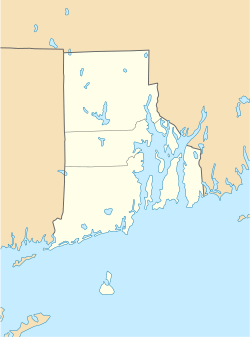Potter Pond facts for kids
Quick facts for kids Potter Pond |
|
|---|---|
| Location | Washington County, Rhode Island, United States |
| Coordinates | 41°23′14″N 71°31′52″W / 41.3873242°N 71.5311693°W |
| Type | saline |
| Basin countries | United States |
Potter Pond (formerly Fish Pond) is a saltwater pond in the town of South Kingstown, Washington County, Rhode Island, United States. It's a special type of water body called a coastal lagoon. This pond is connected to Point Judith Pond through a channel where tides flow in and out. It is one of nine similar "salt ponds" found along the southern coast of Rhode Island. These ponds are important natural areas.
Contents
What is Potter Pond?
Potter Pond is a shallow body of saltwater. It's not a freshwater lake, but rather a part of the ocean system. The water in the pond is salty because it mixes with the ocean's water. This mixing happens through a narrow opening called a tidal inlet. The inlet allows ocean tides to flow into and out of the pond.
A Coastal Lagoon
Potter Pond is known as a coastal lagoon. A lagoon is a shallow body of water that is partly separated from a larger body of water, like the ocean. In this case, the pond is separated from the Atlantic Ocean by a barrier beach or land. However, it still connects to the ocean through its inlet. This connection makes the water salty and allows marine life to move between the pond and the ocean.
Why is it Salty?
The saltiness of Potter Pond comes from the ocean. When the tide rises, ocean water flows into the pond through the inlet. When the tide goes out, some of that water flows back to the ocean. This constant exchange keeps the pond salty. The amount of salt can change a bit depending on rainfall and how much ocean water flows in.
Where is Potter Pond Located?
Potter Pond is found in the state of Rhode Island, which is in the northeastern part of the United States. Specifically, it's in Washington County, Rhode Island, within the town of South Kingstown, Rhode Island.
Part of Rhode Island's Coast
Rhode Island is famous for its beautiful coastline. The southern part of the state has several unique saltwater ponds. Potter Pond is one of these "salt ponds" that locals often talk about. These ponds are a key feature of the region's geography. They are important for both nature and people.
History of Potter Pond
Potter Pond has been known by different names over time. It was once called Fish Pond. This older name likely came from the many fish that lived in its waters. The name change to Potter Pond happened a long time ago.
Why Names Change
Places sometimes change their names for various reasons. It could be to honor a local family, a historical event, or simply to update an old name. The change from Fish Pond to Potter Pond reflects a part of the area's history.
Life in Potter Pond
Potter Pond is a busy place for many kinds of plants and animals. Its salty water and connection to the ocean create a special habitat. Many different species live in and around the pond.
Marine Animals
- Fish: Many types of fish live in the pond, including those that move between the ocean and the pond.
- Shellfish: Clams, oysters, and mussels can be found in the pond's muddy or sandy bottom. These animals filter water and are important for the pond's health.
- Crabs and other creatures: Various crabs, shrimp, and other small invertebrates also make their home here.
Birds and Plants
The pond also supports many bird species, especially those that feed on fish and shellfish. You might see herons, egrets, and various seabirds. Along the edges of the pond, you'll find salt marsh grasses and other plants that can grow in salty soil. These plants provide shelter and food for many animals.
Importance of Salt Ponds
Coastal lagoons like Potter Pond are very important natural resources. They play several key roles in the environment.
Natural Nurseries
These ponds act as nurseries for many marine species. Young fish, crabs, and other creatures often grow up in the calm, protected waters of the pond before moving out to the open ocean. This makes them vital for the health of ocean ecosystems.
Protecting the Coast
Salt ponds also help protect the coastline. They can absorb some of the energy from storms and waves, which helps reduce erosion. They also filter water, improving its quality before it flows back into the ocean.
Recreation and Education
People enjoy Potter Pond for activities like fishing, kayaking, and birdwatching. It's also a great place for learning about coastal ecosystems. Scientists and students often study these ponds to understand how they work and how to protect them.


